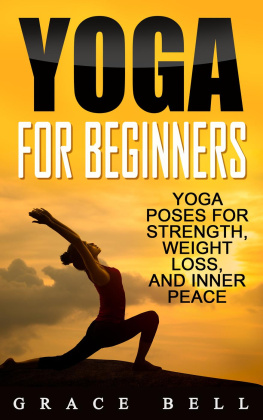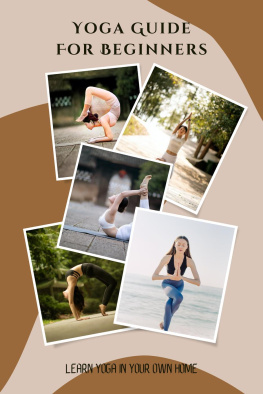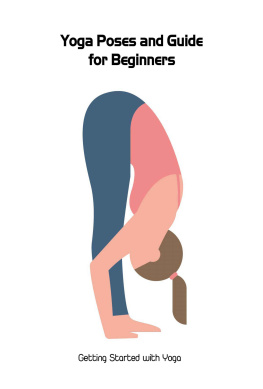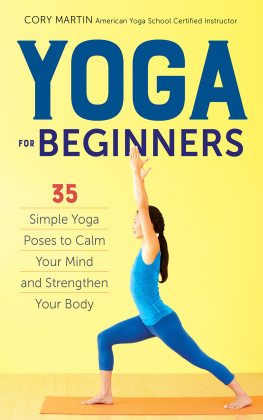No one is immune to minor ailments: headaches, moodiness, stress, insomnia, indigestion, backache and joint pain are just some of the everyday problems we all face. While it is no substitute for treatments prescribed by a qualified doctor, yoga can act in tandem with them to exponentially improve our wellbeing.
Even though yoga has been very popular in the West for several decades, many people still think of it as a strange habit and for good reason! It is a combination of meditation and gymnastics that sometimes seems to incorporate elements of mysticism, and its practitioners (or yogis) describe it as a holistic discipline that seeks to encourage unity of mind and body. This makes it very difficult to classify this phenomenon, which uses meditation and breathing exercises, in the form of the poses ( asanas ) the discipline is best known for, to help individuals bring their mind, body and soul into perfect harmony.
This book provides a brief overview of the history of yoga, from its origins to the many modern variants that have emerged in recent years, and explains its underlying principles and the benefits it can offer. It also features clear explanations of basic yoga poses which you can easily practise at home before working up to the world-famous sun salutation sequence. Plus, once you start practising yoga you will soon start getting to know yourself better and feeling fitter, more optimistic and more in tune with your emotions!
WHAT IS YOGA?
A DISCIPLINE WITH A LONG HISTORY
Although yoga is often thought of as a means of relaxation or a gentler form of exercise that focuses on self-knowledge, it is actually a much more holistic discipline which allows individuals to find (or rediscover) physical and spiritual harmony. It can therefore be considered as a kind of personal development technique that allows us to become more aware of our own senses and emotions. As such, it is hardly surprising that it is often described as a way of finding your true self, both in a physical sense and in a mental and spiritual sense.
DID YOU KNOW?
In Sanskrit, the word yoga is derived from the root yuj , and has a wide variety of meanings: although it is most commonly used to mean union, it can also be translated as yoke, and in certain contexts it may also mean method, technique or discipline. It is therefore unsurprising that meditation (meaning mastery over your own thoughts), moral asceticism and control over your body are some of the key tenets of yoga!
Although Western yoga practices often emphasise the physical aspects of the discipline (through sequences of poses), yoga started out as a branch of Indian philosophy. It can be traced back to the earliest Hindu scriptures (the Vedas), which were written in Northern India in approximately 1500 BCE and were later expanded upon in epics, poems and philosophical essays (the Upanishads). However, it was not until approximately 200 BCE that these texts inspired the rise of six orthodox philosophical systems (the daranam ), including yoga.
After being handed down from generation to generation through oral traditions over a period of many centuries, the principles of yoga were eventually written down; according to Hindu tradition, an individual called Sage Patajali (c. 2 nd century-4 th century CE) played a particularly important role in codifying these principles in the Yoga Sutras. This Yoga Bible consists of 196 aphorisms (or sutras ) which, rather than teaching readers how to strike specific poses, seeks to help them transform their inner selves. This transformation has four stages, each of which corresponds to a level of consciousness and self-control. Yoga does not have any specific religious connotations; on the contrary, it simply acts as a way for us to connect with our inner selves. In practice, this involves engaging with our body and mind simultaneously, being aware of the present moment and acting in accordance with our needs, intentions and values. Embracing our true nature in this way also strengthens our bodies, calms our nervous system and allows us to maximise our concentration.
Yoga aims to help practitioners to overcome mental turmoil and promotes universal values such as respect for others, peace and non-violence. It is often defined according to eight major pillars: moral codes ( yama ), self-purification and study ( niyama ), poses ( asana ), breath control ( pranayama ), withdrawing of the mind from the senses ( pratyahara ), concentration ( dharana ), deep meditation ( dhyana ) and union with the object of meditation ( samadhi ). In other words, yoga is far more than just a series of poses: it is also a way for us to get to know every aspect of ourselves. Indeed, it is a truly holistic approach which allows us to strengthen both our body and mind and bring them into harmony with each other, which in turn enables us to face the challenges of modern life head-on!
A DATE FOR YOUR DIARY
In 2014, the Indian Prime Minister Narendra Modi (born in 1950), who is a practitioner of yoga himself, proclaimed 21 June of each year International Day of Yoga.
CHOOSING A SCHOOL OF YOGA: A BRIEF OVERVIEW
Given that yoga has been around for thousands of years, it should come as no surprise that many different approaches have emerged over time! While most variations of yoga are based on the same fundamental principles, many different techniques and interpretations of these principles have developed in the centuries since the philosophy first came to prominence.
Along with the five major traditional schools of yoga, dozens of modern approaches have also appeared in recent years. As such, you may feel more drawn to one school or another depending on your needs, expectations and comparative level of interest in spirituality, meditation and physical exercise. You may also feel drawn to the approach taught by a specific master yogi. In any case, the following overview of the main schools of yoga should help you to make a more informed decision.
QUICK TIP
Before choosing a school of yoga, take some time to ask yourself the following questions: why do you want to take up yoga? Do you want to strengthen your body, become more flexible or combat stress? Would you prefer to test your limits or just relax? Are you prepared to get to know yourself better and engage in active self-improvement? Do you enjoy meditation and singing? The answers to these questions will give you a better idea of the approaches that would suit you best.
Traditional schools of yoga
Three of the five traditional schools of yoga have only gained a minimal foothold in the West, as they are generally considered more personal approaches to yoga and the emphasis they place on philosophy and mysticism means that they are often associated with religion. They are as follows:
- Bhakti yoga is primarily intended to help practitioners establish spiritual order in their lives by praying regularly, adopting an ascetic lifestyle and obeying certain Hindu teachings.









